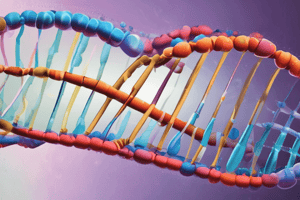Podcast
Questions and Answers
DNA replication is a ______ reaction.
DNA replication is a ______ reaction.
enzyme-catalysed
The ______ nature of DNA replication was first demonstrated by the Meselson-Stahl experiment in 1958.
The ______ nature of DNA replication was first demonstrated by the Meselson-Stahl experiment in 1958.
semi-conservative
DNA polymerase is the main ______ in the replication process.
DNA polymerase is the main ______ in the replication process.
enzyme
The antiparallel nature of DNA strands is needed to form the ______ bonds between the nitrogenous bases.
The antiparallel nature of DNA strands is needed to form the ______ bonds between the nitrogenous bases.
Each newly replicated DNA molecule consists of one original (parental) ______ and one newly synthesized (daughter) strand.
Each newly replicated DNA molecule consists of one original (parental) ______ and one newly synthesized (daughter) strand.
The DNA double helix consists of two strands that run in ______ directions to permit base pairing between them.
The DNA double helix consists of two strands that run in ______ directions to permit base pairing between them.
The process of making proteins occurs in two stages: ______ and translation.
The process of making proteins occurs in two stages: ______ and translation.
During ______, the mRNA works with a ribosome and tRNA to synthesize proteins.
During ______, the mRNA works with a ribosome and tRNA to synthesize proteins.
The enzyme ______ binds to a region of a gene called the promoter to initiate transcription.
The enzyme ______ binds to a region of a gene called the promoter to initiate transcription.
The ______ of nucleotides to the mRNA strand is the ending of transcription.
The ______ of nucleotides to the mRNA strand is the ending of transcription.
The mRNA strand is complete, and it detaches from ______ at the end of transcription.
The mRNA strand is complete, and it detaches from ______ at the end of transcription.
Transcription is the transfer of genetic instructions in ______ to mRNA in the nucleus.
Transcription is the transfer of genetic instructions in ______ to mRNA in the nucleus.
______ unwinds the two strands of DNA at the origin of replication.
______ unwinds the two strands of DNA at the origin of replication.
______ is the main replicative enzyme.
______ is the main replicative enzyme.
______ is synthesised by primase and is complementary to the DNA strand.
______ is synthesised by primase and is complementary to the DNA strand.
______ removes ribonucleotide primers that are used in DNA replication.
______ removes ribonucleotide primers that are used in DNA replication.
______ prevents the supercoiling of DNA.
______ prevents the supercoiling of DNA.
______ fills DNA gaps that arise during DNA replication, repair, and recombination.
______ fills DNA gaps that arise during DNA replication, repair, and recombination.
A peptide bond is formed between the amino acid attached to the tRNA in the ______ site and the methionine in the P site.
A peptide bond is formed between the amino acid attached to the tRNA in the ______ site and the methionine in the P site.
The ribosome now slides down the mRNA, so that the tRNA in the ______ site moves over to the P site.
The ribosome now slides down the mRNA, so that the tRNA in the ______ site moves over to the P site.
The appropriate tRNA carrying the appropriate amino acid pairs bases with this new codon in the ______ site.
The appropriate tRNA carrying the appropriate amino acid pairs bases with this new codon in the ______ site.
The tRNA that was in the ______ site is let go into the cytoplasm, where it will eventually bind with another amino acid.
The tRNA that was in the ______ site is let go into the cytoplasm, where it will eventually bind with another amino acid.
The protein chain connected to the tRNA in the ______ site is released.
The protein chain connected to the tRNA in the ______ site is released.
Many proteins travel to the ______ apparatus within the cytoplasm to be modified for the specific job they will do.
Many proteins travel to the ______ apparatus within the cytoplasm to be modified for the specific job they will do.
Protein synthesis is the process in which cells make ______.
Protein synthesis is the process in which cells make ______.
Transcription is the transfer of genetic instructions in DNA to ______ in the nucleus.
Transcription is the transfer of genetic instructions in DNA to ______ in the nucleus.
Translation occurs at the ______, which consists of rRNA and proteins.
Translation occurs at the ______, which consists of rRNA and proteins.
Then, rRNA helps ______ form between the amino acids, producing a polypeptide chain.
Then, rRNA helps ______ form between the amino acids, producing a polypeptide chain.
After a polypeptide chain is synthesized, it may undergo additional ______ to form the finished protein.
After a polypeptide chain is synthesized, it may undergo additional ______ to form the finished protein.
Flashcards are hidden until you start studying




